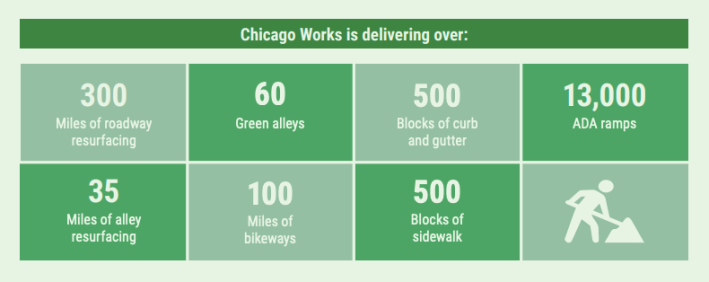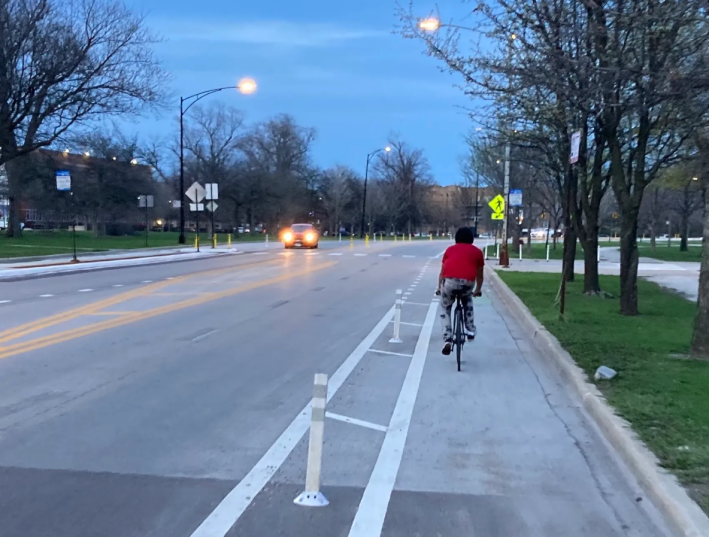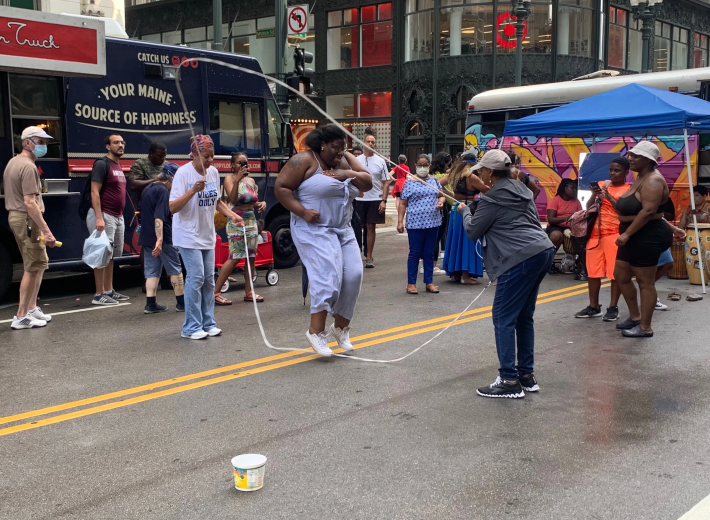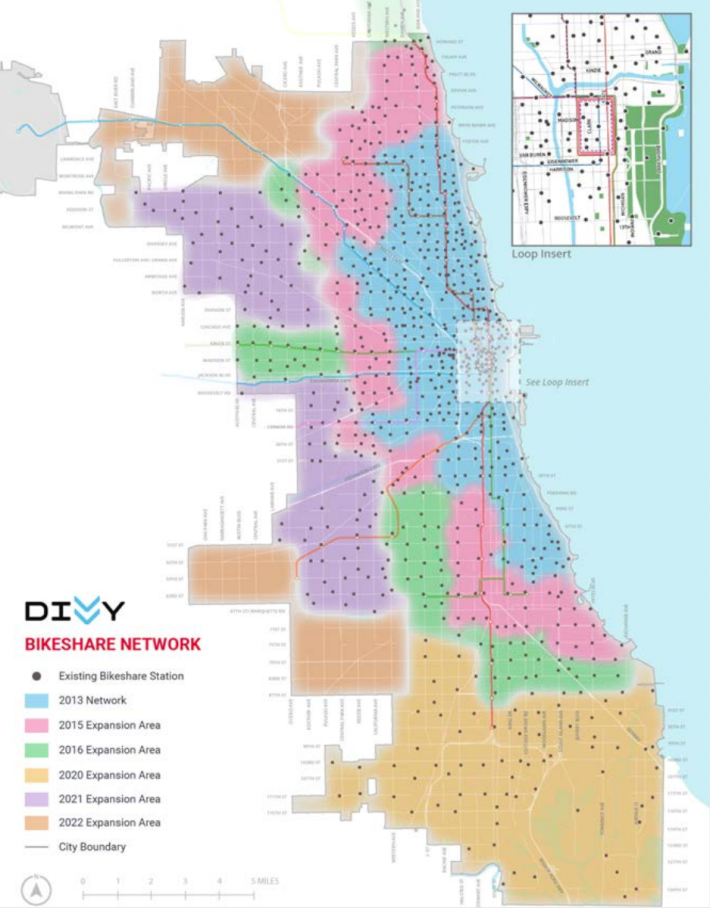In July of 2021, the Chicago Department of Transportation released an extensive three-year Strategic Plan for Transportation. Created with input from the Transportation Equity Network, a coalition of 30 community and advocacy organizations, the document is a roadmap (as it were) for how the agency can improve transportation equity, setting dozens of benchmarks for the first and final years of implementation. I wrote up highlights of the plan for Streetsblog last year, promising to check back in on CDOTs progress.
Eighteen months later, problems identified in the plan have only come into sharper focus. For example, take goal two under the first plan pillar, "access to opportunity": Reduce commute times and improve the transit experience for all Chicagoans. Or goal four in the same category: Reduce congestion on Chicago’s streets. Commutes for CTA riders remain longer than in pre-pandemic times, worsened by ghost trains and buses that fail to show up as scheduled, and plagued by private car-generated traffic jams that slow down buses.
Outcomes related to the "Streets Free from Violence" pillar are far more grim. Goals here include "Reduce dangerous driving on Chicago’s streets" and "Elevate Vision Zero," the city's initiative to eliminate serious and fatal traffic crashes. Never has the city felt further from Vision Zero than in 2022. According to an NBC investigation, there have been 33,000 hit and run crashes in Chicago this year. Drivers have fatally struck at least 30 pedestrians and 8 bicyclists in 2022.
This isn’t to say CDOT has sat on it hands for 18 months. The agency recently issued a one year update listing many improvements made to Chicago streets, with a focus on areas that face economic and mobility hardships, despite significant headwinds.
CDOT met or came very close to hitting several infrastructure benchmarks under the first pillar. Dozens of pedestrian and bicycle accommodations were incorporated into CDOT road resurfacing projects, including over 800 curb extensions and more than 50 bump outs that slow down left-turning drivers and and make it easier for them to see pedestrians in crosswalks.
The Divvy bike-share system also expanded significantly. Since July of 2021, almost 40 square miles were added to the Divvy coverage area, and more than 150 new stations were installed, over 100 of which were placed on South and West Side target areas—not too terribly far from the goal of 200 new stations stated in the original plan. CDOT also exceeded its goal for traffic signal upgrades, adding countdown signals, audible and tactile walk indicators for visually impaired pedestrians, and traffic data collection equipment to more than 80 intersections.
However, other targets in this pillar must be aggressively pursued and exceeded to meet the agency’s stated goal of equitably connecting Chicagoans to their destinations. In 2022, CDOT launched the Better Streets for Buses program, with the goal of speeding up bus service with dedicated lanes, transit signal priority, and other time-saving improvements. Many Chicagoans rely on bus service, particularly in lower-income and Black and Latino neighborhoods with poor 'L' access.
The Active Transportation Alliance is currently campaigning for better bus service, stating that it is critical for a more viable and equitable transit system. With CTA ridership still well below pre-pandemic levels and frustrated riders protesting service gaps and ghost buses that don’t arrive as scheduled, the Better Streets for Buses plan should be put into action as soon as possible to modernize bus service, shorten commutes and draw people out of automobiles and back to transit.
The CDOT Strategic Plan for Transportation update celebrates new bike networks at a neighborhood level, particularly in Austin, Belmont Cragin and North Lawndale. While improving biking at a hyper-local level is a worthy effort, especially in neighborhoods where there was previously little to no bike infrastructure of any kind, Chicago will only become a bike-friendly city when it has a citywide network of protected bike lanes.

Mayor Lori Lightfoot’s "Chicago Works" five-year infrastructure plan speaks directly to the goals in the "aligning our streets with our values" pillar of the transportation plan, which is concerned with how projects are prioritized and how they affect public health. We’re now in year two of Chicago Works and the CDOT plan update states that in the coming years, the program will fund installation of 60 green alleys to reduce stormwater flooding, and add 100 miles of bikeways, 500 blocks of sidewalk, 13,000 ADA ramps, and replace or refurbish of 43 bridges. CDOT also celebrated the $20 million from the federal Infrastructure Investment and Jobs Act that will go toward construction of the Englewood Nature Trail, the conversion of an abandoned train corridor along 59th Street into an elevated walking and biking path.
Completed projects under the second pillar include the replacement of 280,000 sodium lights with high-efficiency LEDs; 57 sidewalk, curb and bus stop improvements; and over 70 parkway tree plantings.

As mentioned above, the third pillar of CDOT’s plan, "streets free from violence," is tragically far from realization. However, the strategic plan update included a few bright spots. There's the road diet that reduced Jackson Boulevard through Austin's Columbus Park from four lanes to three and added bus-boarding islands and protected bike lanes, a redesign that reduced speeding by 75 percent.

The plan also notes the success of Sundays on State and Meet Me on the Mile, summer events that pedestrianized iconic Chicago thoroughfares to make space for dining, street vending, performances and cultural activities. Missing from the update was a promised Slow Streets annual program and request system. Ending the epidemic of traffic violence in Chicago will take a real commitment to road design that prioritizes the safety and experience of all users over cars – including more road diets and Slow Streets – as well as reduction of the default speed limit on residential streets, and enforcement of traffic violations that endanger pedestrians and bicyclists.

The final pillar, "A CDOT that works," looks inward to the agency’s work culture and relationship to the communities it serves. Here, the plan update lists community outreach efforts over the past year, including surveys on the "Chicago Works" program, events to gather input on the Vision Zero South Side Action Plan, budget forums, and adaptive cycling sessions for riders with disabilities.
CDOT’s three-year plan accounted for one to two years of preliminary work: gathering and analyzing data, engaging communities in greatest need, convening advisory groups and setting up systems. Now that we’ve reached the halfway point, I look forward to seeing how CDOT takes the data and turns it into action.






